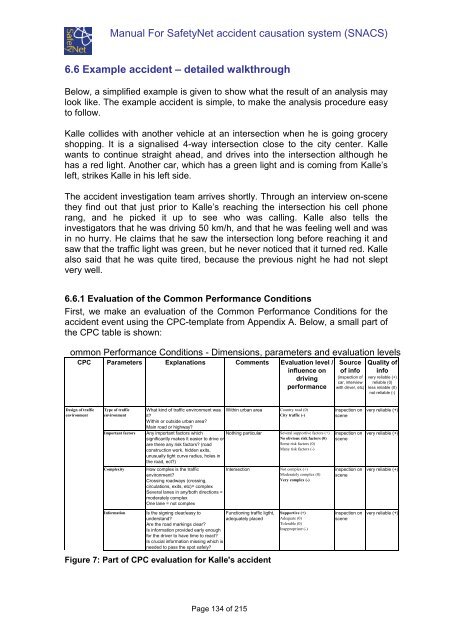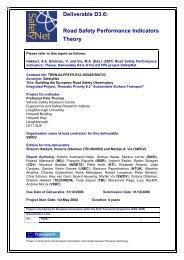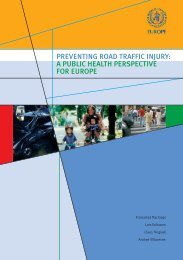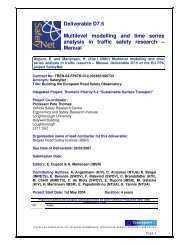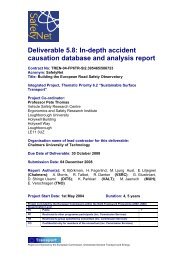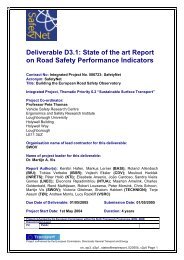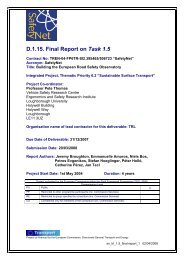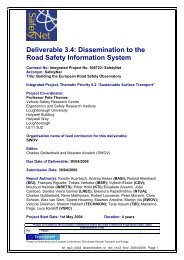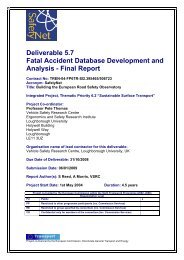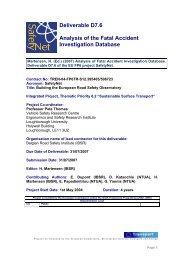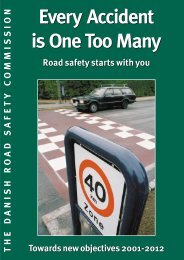Glossary of Data Variables for Fatal and accident causation ... - ERSO
Glossary of Data Variables for Fatal and accident causation ... - ERSO
Glossary of Data Variables for Fatal and accident causation ... - ERSO
You also want an ePaper? Increase the reach of your titles
YUMPU automatically turns print PDFs into web optimized ePapers that Google loves.
Manual For SafetyNet <strong>accident</strong> <strong>causation</strong> system (SNACS)<br />
6.6 Example <strong>accident</strong> – detailed walkthrough<br />
Below, a simplified example is given to show what the result <strong>of</strong> an analysis may<br />
look like. The example <strong>accident</strong> is simple, to make the analysis procedure easy<br />
to follow.<br />
Kalle collides with another vehicle at an intersection when he is going grocery<br />
shopping. It is a signalised 4-way intersection close to the city center. Kalle<br />
wants to continue straight ahead, <strong>and</strong> drives into the intersection although he<br />
has a red light. Another car, which has a green light <strong>and</strong> is coming from Kalle’s<br />
left, strikes Kalle in his left side.<br />
The <strong>accident</strong> investigation team arrives shortly. Through an interview on-scene<br />
they find out that just prior to Kalle’s reaching the intersection his cell phone<br />
rang, <strong>and</strong> he picked it up to see who was calling. Kalle also tells the<br />
investigators that he was driving 50 km/h, <strong>and</strong> that he was feeling well <strong>and</strong> was<br />
in no hurry. He claims that he saw the intersection long be<strong>for</strong>e reaching it <strong>and</strong><br />
saw that the traffic light was green, but he never noticed that it turned red. Kalle<br />
also said that he was quite tired, because the previous night he had not slept<br />
very well.<br />
6.6.1 Evaluation <strong>of</strong> the Common Per<strong>for</strong>mance Conditions<br />
First, we make an evaluation <strong>of</strong> the Common Per<strong>for</strong>mance Conditions <strong>for</strong> the<br />
<strong>accident</strong> event using the CPC-template from Appendix A. Below, a small part <strong>of</strong><br />
the CPC table is shown:<br />
ommon Per<strong>for</strong>mance Conditions - Dimensions, parameters <strong>and</strong> evaluation levels<br />
CPC Parameters Explanations Comments Evaluation level /<br />
influence on<br />
driving<br />
per<strong>for</strong>mance<br />
Source<br />
<strong>of</strong> info<br />
(inspection <strong>of</strong><br />
car, interview<br />
with driver, etc)<br />
Quality <strong>of</strong><br />
info<br />
very reliable (+)<br />
reliable (0)<br />
less reliable (0)<br />
not reliable (-)<br />
Design <strong>of</strong> traffic<br />
environment<br />
Type <strong>of</strong> traffic<br />
environment<br />
Important factors<br />
Complexity<br />
In<strong>for</strong>mation<br />
What kind <strong>of</strong> traffic environment was<br />
it<br />
Within or outside urban area<br />
Main road or highway<br />
Any important factors which<br />
significantly makes it easier to drive or<br />
are there any risk factors (road<br />
construction work, hidden exits,<br />
unusually tight curve radius, holes in<br />
the road, ect)<br />
Within urban area Country road (0)<br />
City traffic (-)<br />
Nothing particular Several supportive factors (+)<br />
No obvious risk factors (0)<br />
Some risk factors (0)<br />
Many risk factors (-)<br />
How complex is the traffic<br />
environment<br />
Crossing roadways (crossing,<br />
circulations, exits, etc)= complex<br />
Several lanes in any/both directions =<br />
moderately complex<br />
One lane = not complex<br />
Intersection Not complex (+)<br />
Moderately complex (0)<br />
Very complex (-)<br />
Is the signing clear/easy to<br />
Functioning traffic ligtht,<br />
underst<strong>and</strong><br />
adequately placed<br />
Are the road markings clear<br />
Is in<strong>for</strong>mation provided early enough<br />
<strong>for</strong> the driver to have time to react<br />
Is crucial in<strong>for</strong>mation missing which is<br />
needed to pass the spot safely<br />
Figure 7: Part <strong>of</strong> CPC evaluation <strong>for</strong> Kalle's <strong>accident</strong><br />
Supportive (+)<br />
Adequate (0)<br />
Tolerable (0)<br />
Inappropriate (-)<br />
inspection on<br />
scene<br />
inspection on<br />
scene<br />
inspection on<br />
scene<br />
inspection on<br />
scene<br />
very reliable (+)<br />
very reliable (+)<br />
very reliable (+)<br />
very reliable (+)<br />
Page 134 <strong>of</strong> 215


